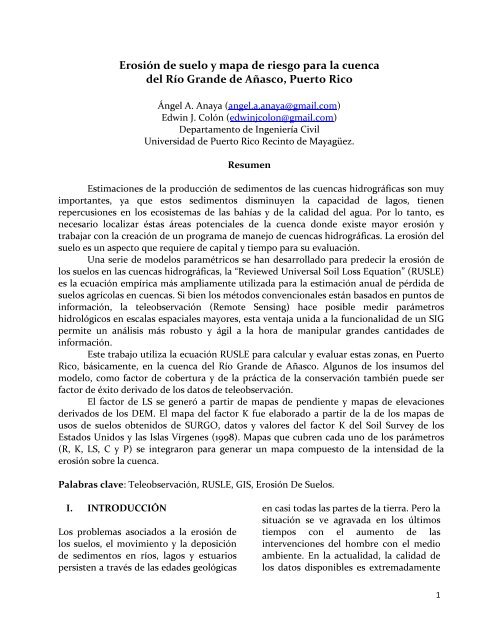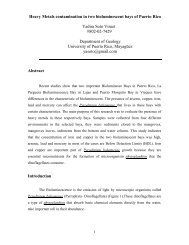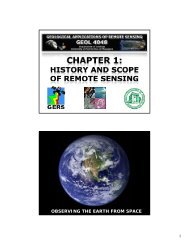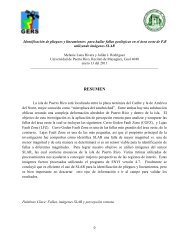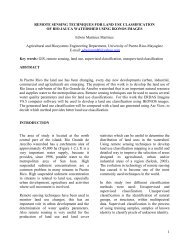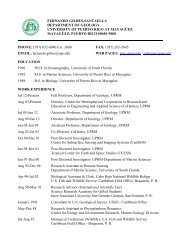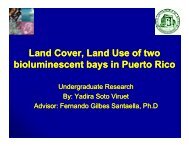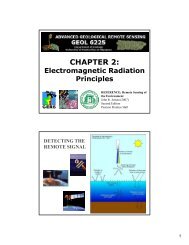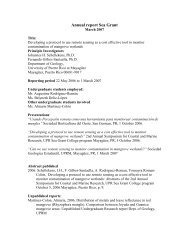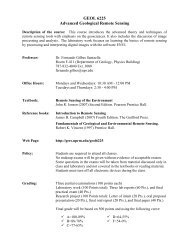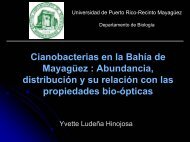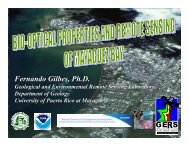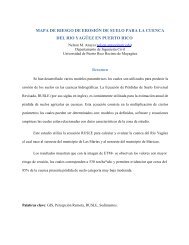Erosión de suelo y mapa de riesgo para la cuenca del Río Grande ...
Erosión de suelo y mapa de riesgo para la cuenca del Río Grande ...
Erosión de suelo y mapa de riesgo para la cuenca del Río Grande ...
Create successful ePaper yourself
Turn your PDF publications into a flip-book with our unique Google optimized e-Paper software.
<strong>Erosión</strong> <strong>de</strong> <strong>suelo</strong> y <strong>mapa</strong> <strong>de</strong> <strong>riesgo</strong> <strong>para</strong> <strong>la</strong> <strong>cuenca</strong><br />
<strong>de</strong>l <strong>Río</strong> Gran<strong>de</strong> <strong>de</strong> Añasco, Puerto Rico<br />
Ángel A. Anaya (angel.a.anaya@gmail.com)<br />
Edwin J. Colón (edwinjcolon@gmail.com)<br />
Departamento <strong>de</strong> Ingeniería Civil<br />
Universidad <strong>de</strong> Puerto Rico Recinto <strong>de</strong> Mayagüez.<br />
Resumen<br />
Estimaciones <strong>de</strong> <strong>la</strong> producción <strong>de</strong> sedimentos <strong>de</strong> <strong>la</strong>s <strong>cuenca</strong>s hidrográficas son muy<br />
importantes, ya que estos sedimentos disminuyen <strong>la</strong> capacidad <strong>de</strong> <strong>la</strong>gos, tienen<br />
repercusiones en los ecosistemas <strong>de</strong> <strong>la</strong>s bahías y <strong>de</strong> <strong>la</strong> calidad <strong>de</strong>l agua. Por lo tanto, es<br />
necesario localizar éstas áreas potenciales <strong>de</strong> <strong>la</strong> <strong>cuenca</strong> don<strong>de</strong> existe mayor erosión y<br />
trabajar con <strong>la</strong> creación <strong>de</strong> un programa <strong>de</strong> manejo <strong>de</strong> <strong>cuenca</strong>s hidrográficas. La erosión <strong>de</strong>l<br />
<strong>suelo</strong> es un aspecto que requiere <strong>de</strong> capital y tiempo <strong>para</strong> su evaluación.<br />
Una serie <strong>de</strong> mo<strong>de</strong>los <strong>para</strong>métricos se han <strong>de</strong>sarrol<strong>la</strong>do <strong>para</strong> pre<strong>de</strong>cir <strong>la</strong> erosión <strong>de</strong><br />
los <strong>suelo</strong>s en <strong>la</strong>s <strong>cuenca</strong>s hidrográficas, <strong>la</strong> “Reviewed Universal Soil Loss Equation” (RUSLE)<br />
es <strong>la</strong> ecuación empírica más ampliamente utilizada <strong>para</strong> <strong>la</strong> estimación anual <strong>de</strong> pérdida <strong>de</strong><br />
<strong>suelo</strong>s agríco<strong>la</strong>s en <strong>cuenca</strong>s. Si bien los métodos convencionales están basados en puntos <strong>de</strong><br />
información, <strong>la</strong> teleobservación (Remote Sensing) hace posible medir parámetros<br />
hidrológicos en esca<strong>la</strong>s espaciales mayores, esta ventaja unida a <strong>la</strong> funcionalidad <strong>de</strong> un SIG<br />
permite un análisis más robusto y ágil a <strong>la</strong> hora <strong>de</strong> manipu<strong>la</strong>r gran<strong>de</strong>s cantida<strong>de</strong>s <strong>de</strong><br />
información.<br />
Este trabajo utiliza <strong>la</strong> ecuación RUSLE <strong>para</strong> calcu<strong>la</strong>r y evaluar estas zonas, en Puerto<br />
Rico, básicamente, en <strong>la</strong> <strong>cuenca</strong> <strong>de</strong>l <strong>Río</strong> Gran<strong>de</strong> <strong>de</strong> Añasco. Algunos <strong>de</strong> los insumos <strong>de</strong>l<br />
mo<strong>de</strong>lo, como factor <strong>de</strong> cobertura y <strong>de</strong> <strong>la</strong> práctica <strong>de</strong> <strong>la</strong> conservación también pue<strong>de</strong> ser<br />
factor <strong>de</strong> éxito <strong>de</strong>rivado <strong>de</strong> los datos <strong>de</strong> teleobservación.<br />
El factor <strong>de</strong> LS se generó a partir <strong>de</strong> <strong>mapa</strong>s <strong>de</strong> pendiente y <strong>mapa</strong>s <strong>de</strong> elevaciones<br />
<strong>de</strong>rivados <strong>de</strong> los DEM. El <strong>mapa</strong> <strong>de</strong>l factor K fue e<strong>la</strong>borado a partir <strong>de</strong> <strong>la</strong> <strong>de</strong> los <strong>mapa</strong>s <strong>de</strong><br />
usos <strong>de</strong> <strong>suelo</strong>s obtenidos <strong>de</strong> SURGO, datos y valores <strong>de</strong>l factor K <strong>de</strong>l Soil Survey <strong>de</strong> los<br />
Estados Unidos y <strong>la</strong>s Is<strong>la</strong>s Vírgenes (1998). Mapas que cubren cada uno <strong>de</strong> los parámetros<br />
(R, K, LS, C y P) se integraron <strong>para</strong> generar un <strong>mapa</strong> compuesto <strong>de</strong> <strong>la</strong> intensidad <strong>de</strong> <strong>la</strong><br />
erosión sobre <strong>la</strong> <strong>cuenca</strong>.<br />
Pa<strong>la</strong>bras c<strong>la</strong>ve: Teleobservación, RUSLE, GIS, <strong>Erosión</strong> De Suelos.<br />
I. INTRODUCCIÓN<br />
Los problemas asociados a <strong>la</strong> erosión <strong>de</strong><br />
los <strong>suelo</strong>s, el movimiento y <strong>la</strong> <strong>de</strong>posición<br />
<strong>de</strong> sedimentos en ríos, <strong>la</strong>gos y estuarios<br />
persisten a través <strong>de</strong> <strong>la</strong>s eda<strong>de</strong>s geológicas<br />
en casi todas <strong>la</strong>s partes <strong>de</strong> <strong>la</strong> tierra. Pero <strong>la</strong><br />
situación se ve agravada en los últimos<br />
tiempos con el aumento <strong>de</strong> <strong>la</strong>s<br />
intervenciones <strong>de</strong>l hombre con el medio<br />
ambiente. En <strong>la</strong> actualidad, <strong>la</strong> calidad <strong>de</strong><br />
los datos disponibles es extremadamente<br />
1
variada. La p<strong>la</strong>nificación <strong>de</strong>l uso <strong>de</strong> tierras<br />
basada en datos poco fiables pue<strong>de</strong><br />
conducir a graves y costosos errores. La<br />
erosión <strong>de</strong>l <strong>suelo</strong> es una investigación<br />
intensidad <strong>de</strong> capital y tiempo.<br />
Extrapo<strong>la</strong>ción global sobre <strong>la</strong> base <strong>de</strong><br />
datos generados por diversos y no<br />
estandarizados métodos pue<strong>de</strong>n dar lugar<br />
a gran<strong>de</strong>s errores y también pue<strong>de</strong><br />
conducir a errores costosos y crítica sobre<br />
cuestiones <strong>de</strong> política. En este estudio, <strong>la</strong><br />
funcionalidad <strong>de</strong> los GIS se utiliza<br />
extensamente en <strong>la</strong> pre<strong>para</strong>ción <strong>de</strong>l <strong>mapa</strong><br />
<strong>de</strong> <strong>la</strong> erosión. La <strong>cuenca</strong> <strong>de</strong>l Rio Gran<strong>de</strong> <strong>de</strong><br />
Añasco está influenciada por el hombre y<br />
el <strong>de</strong>sarrollo <strong>de</strong> <strong>la</strong> erosión <strong>de</strong>l <strong>suelo</strong> y el<br />
transporte <strong>de</strong> sedimentos al <strong>la</strong>go<br />
disminución <strong>de</strong> su capacidad. La<br />
teleobservación proporciona una<br />
conveniente solución <strong>para</strong> este problema.<br />
A<strong>de</strong>más, el volumen <strong>de</strong> datos recogidos<br />
con <strong>la</strong> ayuda <strong>de</strong> técnicas <strong>de</strong><br />
teleobservación son mejor manejados y<br />
utilizados con <strong>la</strong> ayuda <strong>de</strong> los Sistemas <strong>de</strong><br />
Información Geográfica (GIS).<br />
II.<br />
OBJETIVOS DEL ESTUDIO<br />
• Cuantificar <strong>la</strong> cantidad <strong>de</strong><br />
sedimento generado en <strong>la</strong> <strong>cuenca</strong> <strong>de</strong>l<br />
<strong>Río</strong> Gran<strong>de</strong> <strong>de</strong> Añasco, corre<strong>la</strong>cionar<br />
estos valores con los datos históricos<br />
y los patrones <strong>de</strong> sedimentación<br />
actual en <strong>la</strong> bahía.<br />
• Generar un <strong>mapa</strong> <strong>de</strong> <strong>riesgo</strong> <strong>de</strong><br />
erodabilidad a partir <strong>de</strong><br />
c<strong>la</strong>sificaciones <strong>de</strong> los diferentes<br />
parámetros que contro<strong>la</strong>n <strong>la</strong> física <strong>de</strong><br />
este fenómeno.<br />
III.<br />
METODOLOGÍA<br />
La pérdida <strong>de</strong> <strong>suelo</strong> se <strong>de</strong>fine como <strong>la</strong><br />
cantidad <strong>de</strong> <strong>suelo</strong> perdido en un p<strong>la</strong>zo <strong>de</strong><br />
tiempo <strong>de</strong>terminado, en una superficie<br />
<strong>de</strong> <strong>la</strong> tierra que ha sufrido <strong>la</strong> pérdida <strong>de</strong><br />
<strong>suelo</strong> neto. Se expresa en unida<strong>de</strong>s <strong>de</strong><br />
masa por unidad <strong>de</strong> área (Ton ha ‐ 1 y ‐ 1 )<br />
Este documento utiliza <strong>la</strong> Ecuación<br />
Universal <strong>de</strong> Pérdida <strong>de</strong> Suelos Revisada<br />
(RUSLE) La RUSLE pue<strong>de</strong> expresarse <strong>de</strong><br />
<strong>la</strong> siguiente manera:<br />
A = R*K*LS*C*P (1)<br />
Don<strong>de</strong> A es el calcu<strong>la</strong>do <strong>la</strong> pérdida <strong>de</strong><br />
<strong>suelo</strong> por unidad <strong>de</strong> superficie, expresada<br />
en <strong>la</strong>s unida<strong>de</strong>s seleccionadas <strong>para</strong> K y el<br />
período seleccionado <strong>para</strong> R.<br />
(R) = Erosividad <strong>de</strong> <strong>la</strong> lluvia<br />
(K) = Susceptibilidad <strong>de</strong> erosión <strong>de</strong>l <strong>suelo</strong><br />
(L) = Largo <strong>de</strong> <strong>la</strong> pendiente<br />
(S) = Magnitud <strong>de</strong> <strong>la</strong> pendiente<br />
(C) = Cubierta y manejo <strong>de</strong> cultivos<br />
(P) = residuos prácticas <strong>de</strong> conservación<br />
(A) = Pérdida <strong>de</strong> <strong>suelo</strong>s promedio por el<br />
período <strong>de</strong> tiempo representado por R,<br />
generalmente un año.<br />
Figura 1 . Metodología<br />
2
Figura 1, muestra un esquema sobre <strong>la</strong><br />
metodología utilizada en este trabajo.<br />
Incluye los diferentes componentes <strong>de</strong><br />
obtener y calcu<strong>la</strong>r <strong>para</strong> el último cálculo<br />
<strong>de</strong> <strong>la</strong> erosión <strong>de</strong>l <strong>suelo</strong> en Rio Gran<strong>de</strong> <strong>de</strong><br />
Arecibo.<br />
IV.<br />
ÁREA DEL STUDIO<br />
El Rio Gran<strong>de</strong> <strong>de</strong> Añasco y su <strong>cuenca</strong> se<br />
encuentra en <strong>la</strong> costa occi<strong>de</strong>ntal <strong>de</strong><br />
Puerto Rico entre <strong>la</strong>s <strong>la</strong>titu<strong>de</strong>s 18 ° 20'N y<br />
18 ° 05'N y <strong>la</strong>s longitu<strong>de</strong>s 67 ° 15'W y 66 °<br />
45'W.<br />
El <strong>Río</strong> Gran<strong>de</strong> <strong>de</strong> Añasco se origina cerca<br />
<strong>de</strong> <strong>la</strong> Cordillera Central, corrientes al<br />
oeste, y <strong>de</strong>semboca en <strong>la</strong> Bahía <strong>de</strong><br />
Añasco. Tiene su origen <strong>de</strong> <strong>la</strong> unión <strong>de</strong>l<br />
<strong>Río</strong> B<strong>la</strong>nco y el <strong>Río</strong> Prieto en el límite <strong>de</strong>l<br />
Barrio Espino y Pesue<strong>la</strong> <strong>de</strong>l municipio <strong>de</strong><br />
Lares. Cruza por los municipios <strong>de</strong><br />
Adjuntas, Lares, Las Marías, San<br />
Sebastián, Añasco, Mayagüez. Tiene una<br />
longitud aproximada <strong>de</strong> 40 mil<strong>la</strong>s (64<br />
kilómetros) <strong>de</strong>s<strong>de</strong> su origen hasta que<br />
<strong>de</strong>semboca en el Pasaje <strong>de</strong> Mona al oeste<br />
<strong>de</strong> Puerto Rico. Tiene <strong>de</strong> 20 a 60 pies <strong>de</strong><br />
ancho y <strong>de</strong> 2 a 20 pies <strong>de</strong> profundidad.<br />
La parte alta <strong>de</strong> <strong>la</strong> <strong>cuenca</strong> contienen<br />
cuatro embalses conectados por tuberías;<br />
El Lago Toro, Lago Prieto, Lago Guayo, y<br />
el Lago Yahuecas. El valle aluvial <strong>de</strong>l <strong>Río</strong><br />
Gran<strong>de</strong> <strong>de</strong> Añasco cubre un área <strong>de</strong><br />
aproximadamente 18 mi 2 . La <strong>cuenca</strong> es<br />
<strong>de</strong>limitada por colinas al norte, este y<br />
sur, y por <strong>la</strong> Bahía <strong>de</strong> Añasco, al oeste.<br />
Las dos zonas montañosas lo son <strong>la</strong>s<br />
Ca<strong>de</strong>na <strong>de</strong> San Francisco, y <strong>la</strong>s montañas<br />
Ata<strong>la</strong>ya al norte, y <strong>la</strong>s Colinas <strong>de</strong> Uroyán<br />
al sureste. Los afluentes <strong>de</strong>l <strong>Río</strong> Gran<strong>de</strong><br />
<strong>de</strong> Añasco que <strong>de</strong>sembocan aguas abajo<br />
en el l valle son el <strong>Río</strong> Dagüey y el <strong>Río</strong><br />
Cañas. El Caño La Puente y Caño<br />
Boquil<strong>la</strong> son más pequeños arroyos que<br />
atraviesan el valle.<br />
Figura 2. Mapa <strong>de</strong> localización y elevación <strong>de</strong>l<br />
área <strong>de</strong> estudio<br />
Las elevaciones <strong>de</strong>ntro <strong>de</strong> <strong>la</strong> <strong>cuenca</strong><br />
varían <strong>de</strong>s<strong>de</strong> el valle aluvial con 30<br />
metros sobre el nivel medio <strong>de</strong>l mar<br />
hasta su mayor altitud que se encuentra<br />
en <strong>la</strong>s montañas situadas en <strong>la</strong> región en<br />
<strong>la</strong> Cordillera Central, con el Monte<br />
Gui<strong>la</strong>rte a 3953 metros <strong>de</strong> altura sobre el<br />
nivel medio <strong>de</strong>l mar.<br />
V. FACTORES PARA LA<br />
ECUACIÓN (RUSLE)<br />
1200<br />
1150<br />
1100<br />
1050<br />
1000<br />
950<br />
900<br />
850<br />
800<br />
750<br />
700<br />
650<br />
600<br />
550<br />
500<br />
450<br />
400<br />
350<br />
300<br />
250<br />
200<br />
150<br />
100<br />
50<br />
0<br />
FACTOR R<br />
Para calcu<strong>la</strong>r esta parámetro se utilizo<br />
<strong>la</strong> formu<strong>la</strong> <strong>de</strong> Arnoldus, en función <strong>de</strong> <strong>la</strong><br />
precipitación promedio mensual y anual.<br />
3
R= 0.0302 * RI 1.9 (Arnoldus 1980) (2)<br />
Se utilizaron ocho estaciones <strong>de</strong> lluvia<br />
a usar <strong>para</strong> generar <strong>mapa</strong>s <strong>de</strong><br />
precipitación media mensual y anual<br />
mediante el uso <strong>de</strong> algoritmos<br />
geostadísticos como Kriggging y <strong>la</strong><br />
función <strong>de</strong> base radial. (figura 3)<br />
ESTACION<br />
ADJUNTAS 1<br />
NW<br />
ADJUNTAS<br />
SUBSTATION<br />
LARES<br />
LO<br />
N<br />
18<br />
10'<br />
18<br />
10'<br />
18<br />
16'<br />
LA<br />
T ESTE NORTE R<br />
66<br />
43' 741491.9 2009931 832.6867<br />
66<br />
48' 732672.9 2009823 765.1255<br />
66<br />
50' 729014.5 2020852 1005.821<br />
FACTOR K<br />
El factor susceptibilidad <strong>de</strong> erosión <strong>de</strong>l<br />
<strong>suelo</strong>, es <strong>la</strong> tasa <strong>de</strong> pérdida <strong>de</strong> <strong>suelo</strong>s por<br />
unidad EI <strong>para</strong> un <strong>suelo</strong> específico.<br />
Se preparó a partir <strong>de</strong>l <strong>mapa</strong> <strong>de</strong> uso <strong>de</strong><br />
<strong>suelo</strong> <strong>de</strong> <strong>la</strong> <strong>cuenca</strong>, obtenido <strong>de</strong> SSURGO.<br />
Figura 5. (K) susceptibilidad <strong>de</strong> erosión <strong>de</strong>l<br />
<strong>suelo</strong> con unida<strong>de</strong>s <strong>de</strong> Ton*ha*hr*ha ‐1 *MJ*mm ‐1<br />
0.3<br />
0.28<br />
0.26<br />
0.24<br />
0.22<br />
0.2<br />
0.18<br />
0.16<br />
0.14<br />
0.12<br />
0.1<br />
0.08<br />
0.06<br />
0.04<br />
0.02<br />
0<br />
MAYAGUEZ<br />
CITY<br />
MAYAGUEZ<br />
AIRPORT<br />
18<br />
10'<br />
18<br />
15'<br />
67<br />
07' 699164.4 2009451 734.657<br />
67<br />
09' 695544.3 2018639 682.112<br />
FACTOR LS<br />
Para construir el <strong>mapa</strong> raster <strong>de</strong> este<br />
factor <strong>para</strong> <strong>la</strong> <strong>cuenca</strong> se proce<strong>de</strong>rá <strong>de</strong> <strong>la</strong><br />
siguiente forma:<br />
PUERTO<br />
REAL<br />
SAN<br />
SEBASTIAN 2<br />
WNW<br />
18<br />
04'<br />
18<br />
21'<br />
67<br />
10' 693984.2 1998329 319.2235<br />
67<br />
01' 709525.3 2029856 1027.094<br />
• Se calculó el <strong>mapa</strong> <strong>de</strong> pendientes a<br />
partir <strong>de</strong>l mdt.<br />
• Se calculó el <strong>mapa</strong> LS a partir <strong>de</strong> <strong>la</strong><br />
metodología propuesta por SURGO<br />
UTUADO<br />
18<br />
16'<br />
66<br />
40' 746642.5 2021069 638.485<br />
Figura 3. Estaciones <strong>de</strong>l USGS<br />
Figura 4. (R) Erosividad por lluvia con<br />
unida<strong>de</strong>s <strong>de</strong> MJ*ha ‐1 *mm*hr ‐1<br />
950<br />
900<br />
850<br />
800<br />
750<br />
700<br />
650<br />
600<br />
550<br />
500<br />
450<br />
400<br />
350<br />
300<br />
250<br />
200<br />
150<br />
100<br />
50<br />
0<br />
LS = f(L, S) (3)<br />
Uso <strong>de</strong> <strong>la</strong> DEM (Digital Elevation Mo<strong>de</strong>l)<br />
con 30 metros <strong>de</strong> resolución espacial<br />
<strong>para</strong> <strong>la</strong> zona <strong>de</strong> estudio, el factor <strong>de</strong> L * S<br />
se calculó utilizando:<br />
LS = L/22*(0.065+0.045*S+0.0065*S 2 )<br />
(4)<br />
L = longitud (metros) fija a 30 metros.<br />
S = pendiente (radianes).<br />
4
El <strong>mapa</strong> <strong>de</strong>l factor <strong>de</strong> LS fue creado a<br />
partir <strong>de</strong> los DEM y el cálculo <strong>de</strong><br />
pendientes, primero en <strong>la</strong> obtención <strong>de</strong><br />
<strong>la</strong> red en cada píxel un valor <strong>de</strong> LS.<br />
Figura 6. (LS) Características <strong>de</strong> <strong>la</strong>s pendientes<br />
<strong>de</strong>l <strong>suelo</strong> con unida<strong>de</strong>s <strong>de</strong> Ton*ha ‐1 *yr ‐1<br />
FACTOR C<br />
El factor cubierta y manejo, es<br />
función <strong>de</strong>l tipo <strong>de</strong> vegetación, Para<br />
calcu<strong>la</strong>r este parámetro se usaran<br />
imágenes satelitales, <strong>de</strong> sensores MSS,<br />
TM y ETM, a resolución <strong>de</strong> pixel <strong>de</strong> 30<br />
metros, y con una ventana temporal <strong>de</strong><br />
<strong>de</strong>s<strong>de</strong> los 70’s hasta imágenes<br />
posteriores al 2000.<br />
20<br />
19<br />
18<br />
17<br />
16<br />
15<br />
14<br />
13<br />
12<br />
11<br />
10<br />
9<br />
8<br />
7<br />
6<br />
5<br />
4<br />
3<br />
2<br />
1<br />
0<br />
Figura 8 . Imagen color verda<strong>de</strong>ro <strong>de</strong>l sensor<br />
TM<br />
Figura 9. Imagen color verda<strong>de</strong>ro <strong>de</strong>l sensor<br />
ETM+<br />
Aplicando una c<strong>la</strong>sificación no<br />
supervisada <strong>de</strong>l tipo K medios utilizando<br />
el programa ENVI 4.3 con 8 c<strong>la</strong>ses y 5<br />
iteraciones se obtuvo los siguientes<br />
resultados (figura , , )<br />
Se comenzó creando un “subset” <strong>de</strong> <strong>la</strong>s<br />
imágenes <strong>de</strong>l “Path”: 005 y “Row”: 047<br />
<strong>para</strong> que solo incluyera el área <strong>de</strong>seada<br />
<strong>para</strong> el estudio. (figuras 7, 8, 9 )<br />
Figura 10. Kmeans <strong>de</strong> <strong>la</strong> imagen <strong>de</strong>l MSS<br />
Figura 7. Imagen color falso <strong>de</strong>l sensor MSS<br />
Figura 11 . Kmeans <strong>de</strong> <strong>la</strong> imagen <strong>de</strong>l TM<br />
5
Figura 12 . Kmeans <strong>de</strong> <strong>la</strong> imagen <strong>de</strong>l ETM+<br />
CATEGORIA<br />
Cuerpos <strong>de</strong> agua 0<br />
Bosque Denso 0.002<br />
Bosque Medio 0.006<br />
Grama 0.12<br />
Cultivos 0.1<br />
Ciudad 0<br />
Figura 13 .Valores utilizados <strong>para</strong> C por c<strong>la</strong>se.<br />
Combinando estos valores con el<br />
resultado <strong>de</strong> <strong>la</strong> c<strong>la</strong>sificación <strong>de</strong>l K medios<br />
y <strong>la</strong> máscara <strong>de</strong> <strong>la</strong> <strong>cuenca</strong> se producen los<br />
<strong>mapa</strong>s <strong>de</strong>l factor C <strong>para</strong> <strong>la</strong>s tres<br />
imágenes. (figuras 14, 15, 16)<br />
MSS<br />
Figura 14 . (C) Cubierta y manejo <strong>de</strong> cultivos<br />
MSS<br />
C<br />
0.115<br />
0.11<br />
0.105<br />
0.1<br />
0.095<br />
0.09<br />
0.085<br />
0.08<br />
0.075<br />
0.07<br />
0.065<br />
0.06<br />
0.055<br />
0.05<br />
0.045<br />
0.04<br />
0.035<br />
0.03<br />
0.025<br />
0.02<br />
0.015<br />
0.01<br />
0.005<br />
0<br />
TM<br />
Figura 15 . (C) Cubierta y manejo <strong>de</strong> cultivos<br />
TM<br />
ETM+<br />
VI.<br />
Figura 15 . (C) Cubierta y manejo <strong>de</strong> cultivos<br />
ETM+<br />
MAPAS DE EROSIÓN<br />
0.115<br />
0.11<br />
0.105<br />
0.1<br />
0.095<br />
0.09<br />
0.085<br />
0.08<br />
0.075<br />
0.07<br />
0.065<br />
0.06<br />
0.055<br />
0.05<br />
0.045<br />
0.04<br />
0.035<br />
0.03<br />
0.025<br />
0.02<br />
0.015<br />
0.01<br />
0.005<br />
0<br />
0.115<br />
0.11<br />
0.105<br />
0.1<br />
0.095<br />
0.09<br />
0.085<br />
0.08<br />
0.075<br />
0.07<br />
0.065<br />
0.06<br />
0.055<br />
0.05<br />
0.045<br />
0.04<br />
0.035<br />
0.03<br />
0.025<br />
0.02<br />
0.015<br />
0.01<br />
0.005<br />
0<br />
Todos los <strong>mapa</strong>s <strong>de</strong> los valores <strong>de</strong> R,<br />
K, LS y C fueron integrados en varios<br />
<strong>mapa</strong>s <strong>para</strong> producir los <strong>mapa</strong>s <strong>de</strong><br />
intensidad <strong>de</strong> erosión <strong>para</strong> cada<br />
imagen. Las figuras 16‐18 muestran el<br />
resultado final <strong>de</strong> este proceso <strong>para</strong> <strong>la</strong><br />
cueca <strong>de</strong>l Rio Gran<strong>de</strong> <strong>de</strong> Añasco.<br />
6
MSS<br />
600<br />
VII.<br />
RESULTADOS<br />
550<br />
500<br />
450<br />
400<br />
INTENSIDAD RANG MSS TM ETM+<br />
O<br />
Muy Baja 0‐5 30.09% 42.16 % 27.25 %<br />
350<br />
300<br />
250<br />
Baja 5‐12 22.38 % 14.93 % 23.00 %<br />
200<br />
Figura 16. Mapa <strong>de</strong> erosión usando MSS<br />
150<br />
100<br />
50<br />
0<br />
Mo<strong>de</strong>rada 12‐25 5.98 % 3.78 % 5.00 %<br />
Alta 25‐60 10.30 % 11.04% 11.63 %<br />
Muy Alta 60‐150 4.69 % 6.70 % 6.12 %<br />
TM<br />
550<br />
Extremadamen<br />
te Alta<br />
> 150 26.56 % 21.39 % 27.00 %<br />
500<br />
450<br />
400<br />
350<br />
300<br />
250<br />
200<br />
150<br />
100<br />
50<br />
Figura 19. Resultados <strong>de</strong> <strong>la</strong>s <strong>mapa</strong>s generados<br />
(porciento <strong>de</strong> pixeles)<br />
Las variaciones en los números se <strong>de</strong>ben<br />
a que <strong>la</strong>s imágenes fueron re‐calibradas a<br />
un tamaño <strong>de</strong> pixel <strong>de</strong> 30 x 30 y <strong>la</strong>s fotos<br />
no son <strong>de</strong>l mismo año.<br />
Figura 17. Mapa <strong>de</strong> erosión usando TM<br />
0<br />
ETM+<br />
600<br />
VIII.<br />
CONCLUSIONES<br />
Figura 18. Mapa <strong>de</strong> erosión usando ETM+<br />
550<br />
500<br />
450<br />
400<br />
350<br />
300<br />
250<br />
200<br />
150<br />
100<br />
50<br />
0<br />
Los valores más críticos <strong>de</strong> pérdida <strong>de</strong><br />
<strong>suelo</strong> fueron obtenidos usando el <strong>mapa</strong><br />
<strong>de</strong> cobertura generado a partir <strong>de</strong> <strong>la</strong><br />
imagen ETM, con valores máximos <strong>de</strong><br />
606 Ton por hectárea ano, a<strong>de</strong>más el<br />
producto generado indica que<br />
aproximadamente el 44% <strong>de</strong> <strong>la</strong> <strong>cuenca</strong><br />
presenta pérdida <strong>de</strong> <strong>suelo</strong> categoría altaextremadamente<br />
alta.<br />
Com<strong>para</strong>ndo los resultados con “The<br />
Average Annual Soil Erosion by Water on<br />
7
Cultivated Crop<strong>la</strong>nd as a Portion of the<br />
Tolerable Rate, 1997.” Que presenta<br />
valores promedio <strong>para</strong> Puerto Rico entre<br />
2 y 4 ton/ha/año, se observa que <strong>la</strong><br />
<strong>cuenca</strong> <strong>de</strong>l rio gran<strong>de</strong> <strong>de</strong> Añasco presenta<br />
valores muy superiores a <strong>la</strong> media con<br />
valores <strong>de</strong> 0‐12 ton/ha/año.<br />
IX.<br />
REFERENCIAS<br />
Ogawa, S. Saito, G. et al. 1997. Estimation<br />
of Soil erosion using USLE and Landsat TM<br />
in Pakistan. ACRS 1997 Proceedings.<br />
Samad, R., Abdul, N. 1997. Soil Erosion<br />
and Hydrological Study of the Bakun Dam<br />
Catchment Area, Sarawak Using Remote<br />
Sensing and Geographic Information System<br />
(GIS). ACRS 1997 Proceedings.<br />
www.<strong>la</strong>ndsat.org<br />
water.usgs.gov<br />
ssurgo.usgs.gov<br />
www.ott.wrcc.osmre.gov<br />
8


